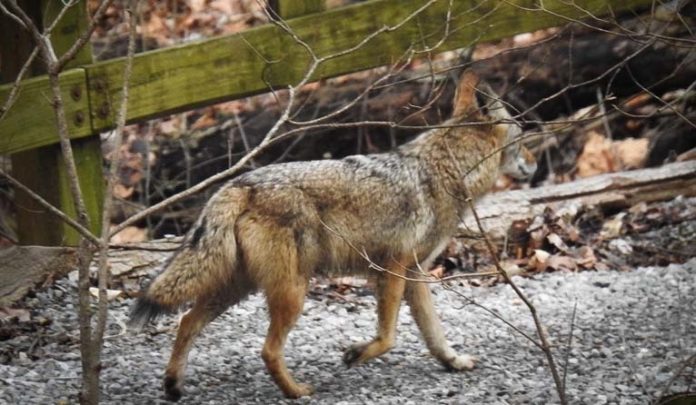Coyotes (Canis latrans) are native to Indiana and were often called “prairie wolves.†Before the European settlement of Indiana, coyotes were primarily restricted to prairie regions of the state. Today, coyotes are found throughout Indiana, including urban areas.
- The coyote closely resembles a German shepherd dog in height and shape but it carries its tail below the level of its back instead of curved upward and is generally half the weight of a German shepherd.
- Coyotes have a long slender snout and large, pointed ears.
- The upper body is a grizzled gray or buff, with a reddish brown or gray muzzle and legs. The belly is white, cream-colored or reddish yellow.
- The coyote has a bushy tail, which it carries below the level of its back.
- Coyotes average 25 pounds (ranging from 20 to 50 pounds), and they measure 40 to 50 inches long from nose to tail tip.
- Coyotes are elusive and normally avoid humans.
- They can be active day or night, but are typically most active at dawn and dusk.
- The coyote communicates by barking, yipping and howling.
- Coyotes are present in all sections of the state. There are records of coyotes in Indiana as early as 1816, though they likely inhabited Indiana well before that time. Bounties were in place in Indiana on coyotes from at least 1849 through the late 1960s. Despite this persecution by early European settlers, coyotes persisted in Indiana. Historically, coyote populations were limited in range to the prairie regions of the state, and expansion may have partially been limited because wolves suppress coyote populations, and both red and gray wolves were once abundant in Indiana. However, with the eradication of wolves and conversion of habitat to farmland, coyotes have been able to expand and adapt to new habitats. Statewide coyote abundance has slowly increased as coyotes continued to expand into previously unoccupied habitat. Today, coyotes occupy all of Indiana, no matter the habitat type or amount of development.
- Coyotes may pair for life. They mate in February, and a litter with an average of four to six pups is born in a den in April. Dens may be located in a bank, rock outcropping, cave, or an enlarged woodchuck or rabbit burrow. Males help raise the pups and provide the female with food when pups are very young. Pups begin playing at the entrance of their den at 3- to 4-weeks old, and by 10 weeks they may leave the den completely. Pups learn to hunt during the fall and generally disperse before they turn 1 year old. Occasionally, a female yearling or two may stick around another year and help raise the next year’s pups.
Food habits
- Coyotes are opportunistic foragers that will consume anything of nutritional value.
- Coyotes primarily feed on small mammals, rabbits, and squirrels, even in urban environments. But they will not turn down an easy meal, nor will they pass up a free meal from human-provided food sources.
- They will scavenge exposed garbage or other refuse, and may even kill and consume house cats and small dogs.
- Besides small mammals, rabbits, and squirrels, coyotes may also eat  fruit, insects, poultry, livestock, deer (especially fawns and road-killed deer), songbirds and sometimes game birds.
Management and control
Hunting and trapping are important components of managing coyotes in Indiana. However, not all coyotes are problem coyotes. Many coyotes live around people, pets and livestock and never have negative interactions with them. When coyotes become habituated to people, problems can occur, and those animals may need to be removed. Similarly, when coyotes begin to prey upon livestock, those animals may need to be removed to stop damage from occurring. Removing coyotes not causing problems around livestock can encourage new coyotes to move in which may cause damage.
People’s behavior is usually a key component in habituation occurring, so it’s important for people to do their best to discourage coyotes whenever possible..





